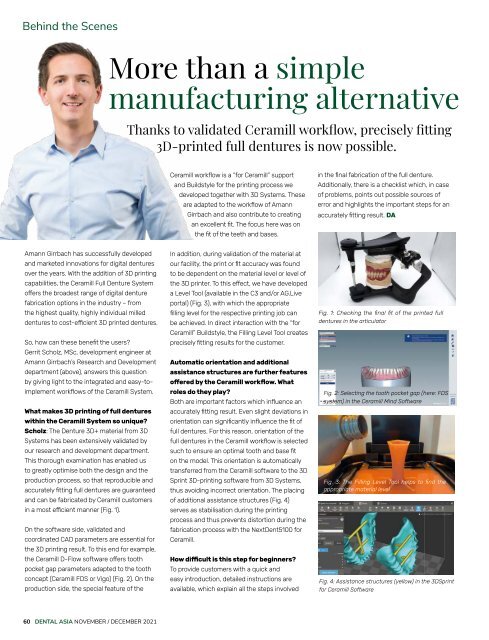Dental Asia November/December 2021
For more than two decades, Dental Asia is the premium journal in linking dental innovators and manufacturers to its rightful audience. We devote ourselves in showcasing the latest dental technology and share evidence-based clinical philosophies to serve as an educational platform to dental professionals. Our combined portfolio of print and digital media also allows us to reach a wider market and secure our position as the leading dental media in the Asia Pacific region while facilitating global interactions among our readers.
For more than two decades, Dental Asia is the premium journal in linking dental innovators
and manufacturers to its rightful audience. We devote ourselves in showcasing the latest dental technology and share evidence-based clinical philosophies to serve as an educational platform to dental professionals. Our combined portfolio of print and digital media also allows us to reach a wider market and secure our position as the leading dental media in the Asia Pacific region while facilitating global interactions among our readers.
You also want an ePaper? Increase the reach of your titles
YUMPU automatically turns print PDFs into web optimized ePapers that Google loves.
Behind the Scenes<br />
More than a simple<br />
manufacturing alternative<br />
Thanks to validated Ceramill workflow, precisely fitting<br />
3D-printed full dentures is now possible.<br />
Ceramill workflow is a “for Ceramill” support<br />
and Buildstyle for the printing process we<br />
developed together with 3D Systems. These<br />
are adapted to the workflow of Amann<br />
Girrbach and also contribute to creating<br />
an excellent fit. The focus here was on<br />
the fit of the teeth and bases.<br />
in the final fabrication of the full denture.<br />
Additionally, there is a checklist which, in case<br />
of problems, points out possible sources of<br />
error and highlights the important steps for an<br />
accurately fitting result. DA<br />
Amann Girrbach has successfully developed<br />
and marketed innovations for digital dentures<br />
over the years. With the addition of 3D printing<br />
capabilities, the Ceramill Full Denture System<br />
offers the broadest range of digital denture<br />
fabrication options in the industry – from<br />
the highest quality, highly individual milled<br />
dentures to cost-efficient 3D printed dentures.<br />
So, how can these benefit the users?<br />
Gerrit Scholz, MSc, development engineer at<br />
Amann Girrbach’s Research and Development<br />
department (above), answers this question<br />
by giving light to the integrated and easy-toimplement<br />
workflows of the Ceramill System.<br />
What makes 3D printing of full dentures<br />
within the Ceramill System so unique?<br />
Scholz: The Denture 3D+ material from 3D<br />
Systems has been extensively validated by<br />
our research and development department.<br />
This thorough examination has enabled us<br />
to greatly optimise both the design and the<br />
production process, so that reproducible and<br />
accurately fitting full dentures are guaranteed<br />
and can be fabricated by Ceramill customers<br />
in a most efficient manner (Fig. 1).<br />
On the software side, validated and<br />
coordinated CAD parameters are essential for<br />
the 3D printing result. To this end for example,<br />
the Ceramill D-Flow software offers tooth<br />
pocket gap parameters adapted to the tooth<br />
concept (Ceramill FDS or Vigo) (Fig. 2). On the<br />
production side, the special feature of the<br />
In addition, during validation of the material at<br />
our facility, the print or fit accuracy was found<br />
to be dependent on the material level or level of<br />
the 3D printer. To this effect, we have developed<br />
a Level Tool (available in the C3 and/or AG.Live<br />
portal) (Fig. 3), with which the appropriate<br />
filling level for the respective printing job can<br />
be achieved. In direct interaction with the “for<br />
Ceramill” Buildstyle, the Filling Level Tool creates<br />
precisely fitting results for the customer.<br />
Automatic orientation and additional<br />
assistance structures are further features<br />
offered by the Ceramill workflow. What<br />
roles do they play?<br />
Both are important factors which influence an<br />
accurately fitting result. Even slight deviations in<br />
orientation can significantly influence the fit of<br />
full dentures. For this reason, orientation of the<br />
full dentures in the Ceramill workflow is selected<br />
such to ensure an optimal tooth and base fit<br />
on the model. This orientation is automatically<br />
transferred from the Ceramill software to the 3D<br />
Sprint 3D-printing software from 3D Systems,<br />
thus avoiding incorrect orientation. The placing<br />
of additional assistance structures (Fig. 4)<br />
serves as stabilisation during the printing<br />
process and thus prevents distortion during the<br />
fabrication process with the NextDent5100 for<br />
Ceramill.<br />
How difficult is this step for beginners?<br />
To provide customers with a quick and<br />
easy introduction, detailed instructions are<br />
available, which explain all the steps involved<br />
Fig. 1: Checking the final fit of the printed full<br />
dentures in the articulator<br />
Fig. 2: Selecting the tooth pocket gap (here: FDS<br />
system) in the Ceramill Mind Software<br />
Fig. 3: The Filling Level Tool helps to find the<br />
appropriate material level<br />
Fig. 4: Assistance structures (yellow) in the 3DSprint<br />
for Ceramill Software<br />
60<br />
DENTAL ASIA NOVEMBER / DECEMBER <strong>2021</strong>


















